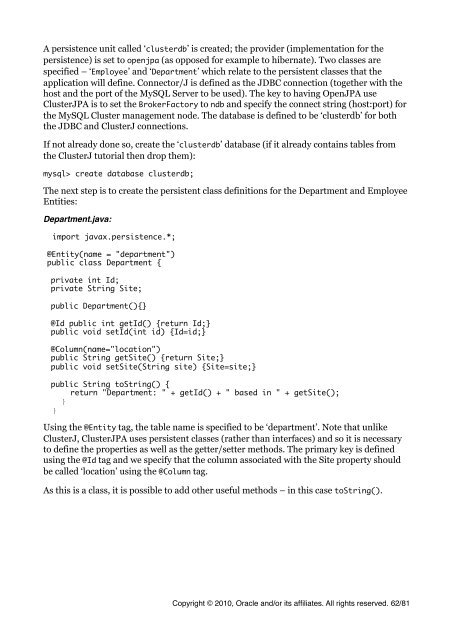MySQL Cluster Tutorial - cdn.oreillystatic.com
MySQL Cluster Tutorial - cdn.oreillystatic.com
MySQL Cluster Tutorial - cdn.oreillystatic.com
You also want an ePaper? Increase the reach of your titles
YUMPU automatically turns print PDFs into web optimized ePapers that Google loves.
A persistence unit called ‘clusterdb’ is created; the provider (implementation for the<br />
persistence) is set to openjpa (as opposed for example to hibernate). Two classes are<br />
specified – ‘Employee’ and ‘Department’ which relate to the persistent classes that the<br />
application will define. Connector/J is defined as the JDBC connection (together with the<br />
host and the port of the <strong>MySQL</strong> Server to be used). The key to having OpenJPA use<br />
<strong>Cluster</strong>JPA is to set the BrokerFactory to ndb and specify the connect string (host:port) for<br />
the <strong>MySQL</strong> <strong>Cluster</strong> management node. The database is defined to be ‘clusterdb’ for both<br />
the JDBC and <strong>Cluster</strong>J connections.<br />
If not already done so, create the ‘clusterdb’ database (if it already contains tables from<br />
the <strong>Cluster</strong>J tutorial then drop them):<br />
mysql> create database clusterdb;<br />
The next step is to create the persistent class definitions for the Department and Employee<br />
Entities:<br />
Department.java:<br />
import javax.persistence.*;<br />
@Entity(name = "department")<br />
public class Department {<br />
private int Id;<br />
private String Site;<br />
public Department(){}<br />
@Id public int getId() {return Id;}<br />
public void setId(int id) {Id=id;}<br />
@Column(name="location")<br />
public String getSite() {return Site;}<br />
public void setSite(String site) {Site=site;}<br />
public String toString() {<br />
return "Department: " + getId() + " based in " + getSite();<br />
}<br />
}<br />
Using the @Entity tag, the table name is specified to be ‘department’. Note that unlike<br />
<strong>Cluster</strong>J, <strong>Cluster</strong>JPA uses persistent classes (rather than interfaces) and so it is necessary<br />
to define the properties as well as the getter/setter methods. The primary key is defined<br />
using the @Id tag and we specify that the column associated with the Site property should<br />
be called ‘location’ using the @Column tag.<br />
As this is a class, it is possible to add other useful methods – in this case toString().<br />
Copyright © 2010, Oracle and/or its affiliates. All rights reserved. 62/81
















